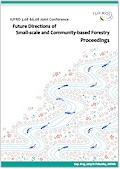| Paper |
 |
|
| Title | Strategy for value creation: Intermediaries of smallholding teak in lndonesia | | Author | Aulia Perdana and James M Roshetko | | Year | 2013 | | Parent Title | Proceedings Future Direction of Small-scale and Community-based Forestry, September 8-13, 2013, Fukuoka, Japan | | Publisher | IUFRO | | City of Publication | Fukuoka, Japan | | Pages | 356-366 | | Call Number | PP0345-14 |
|
| Abstract: |
Commercially traded smallholder timber, particularly teak, in developing countries have been
challenged with the unremitting problem of low returns (Carsan and Holding 2006, Midgley et a1 2007,
Aoudji et a1 2012, Sabastian et a1 2012, Rohadi et a1 2012). For Indonesian smallholder teak, it is due to
low tree quality standards (Roshetko 2012)) unfavourable policies (Rohadi et al 2012)) lacking
accessible market information, weak bargaining power, and high transaction costs (Midgley et a1 2007,
Perdana et al 2012).
In Indonesia, most teak plantations are on Java, where the largest grower, Perum Perhutani, a
state-owned forest enterprise, manages 2,442,101 ha of teak plantation (Perhutani 2010). In addition
to Perum Perhutani, there are approximately 1.2 million ha of smallholders' plantations in lndonesia
that primarily produce teak (Nawir et al. 2007). Smallholding plantations rarely use improved
germplasm or benefit from silvicultural management such as fertilizer application, weeding, thinning
and pruning. Smallholders' teak is different from long-rotation industrial plantations that benefit from
professional management, smallholders' logs are shorter, have smaller diameter, less clear wood, more
knots, and obtain lower prices (Roshetko and Manurung 2009). Despite these shortcomings,
smallholding teak plantations are an important source of wood for many teak manufacturers and
retailers in Indonesia. |
|